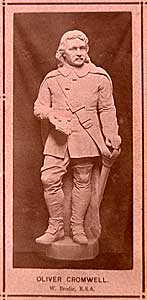 |
Oliver Cromwell
Found on the south facade of the Scott Monument, opposite Balfour
of Burley, beside the Museum Room window.
Oliver Cromwell (from the novel 'Woodstock', 1826), is depicted
in tunic and trews, with a broad belt across his chest, left hand
resting on his sword and a book in the other.
Cromwell plays a major role in the novel, and Scott was careful
to draw his character as fully as possible.
"His demeanour was so blunt as sometimes might be
termed clownish, yet there was in his language and manner a force
and energy corresponding to his character, which impressed awe,
if it did not impose respect…Something there was in his disposition
congenial to that of his countrymen; a contempt of folly, a hatred
of affectation, and a dislike of ceremony, which, joined to the
strong intrinsic qualities of sense and courage, made him in many
respects not an unfit representative of the democracy of England."
Faced with the portrait of the executed Charles I, he seems to
struggle with his conscience under the reproaches of "that
cold, calm face - that proud yet complaining eye". But he wavers
only for a moment: "Not wealth nor power brought me from my
obscurity. The oppressed consciences - the injured liberties of
England - were the banner that I followed."
About the Sculptor
William Brodie (1815 to 1881)
William Brodie was born in Banff on 22 January and died in Edinburgh
30 October 1881. He was the son of a shipmaster who moved to Aberdeen
with his family. William was apprenticed as a plumber and studied
at the Mechanics Institute,where he began casting small figures
in lead. He developed onto modelling medallion portraits and in
1847 was encouraged to study at the Trustees School of Design, where
he learnt to model on a larger scale. One of his first works was
a bust of his patron Lord Jeffrey.
He was elected ARSA (Associate of the Royal Scottish Academy) in
1851, RSA in 1859 and became Secretary of the RSA (Royal Scottish
Academy) in 1876.
Other works in bronze include: ‘Greyfriars Bobby’ (1872)
near Greyfriars Kirkyard; ‘A Peer and his Lady Doing Homage’
(1875) for the Prince Consort Memorial in Charlotte Square, Sir
James Young Simpson (1877) Princes Street West.
Other works in stone are ‘The Genius of Architecture crowning
the Theory and Practice of the Art’ and the monument to Dugald
Stewart on Calton Hill, a portrait bust of Rev. John Paul in St.
Cuthberts church, as well as several on the Scott Monument - Jeanie
Deans, The Earl of Leicester, Amy Robsart, Edith of Lorn, Oliver
Cromwell, Helen MacGregor,and Madge Wildfire.
‘In portraiture Brodie had a peculiarly happy knack
of catching the likeness. Furthermore, it was almost always a pleasing
and characteristic likeness elevated without being over idealised.’
- Quote taken from the dictionary of Scottish Art and Architecture.
^ back to the top |



